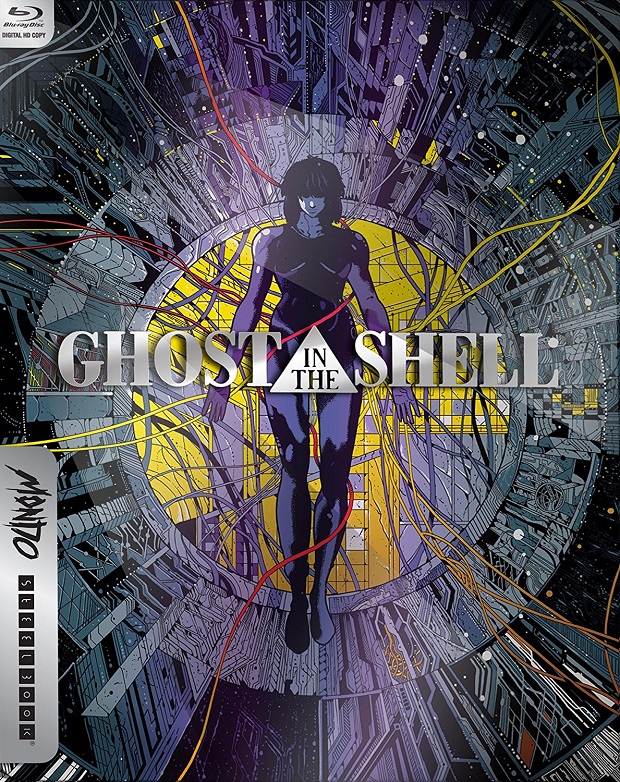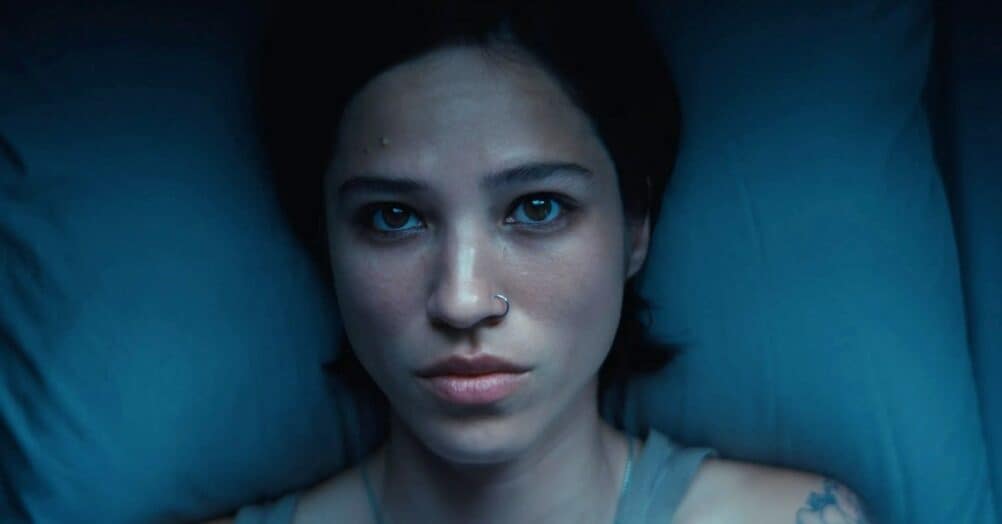Last Updated on August 2, 2021

We all have certain movies we love. Movies we respect without question because of either tradition, childhood love, or because they’ve always been classics. However, as time keeps ticking, do those classics still hold up? Do they remain must see? So…the point of this column is to determine how a film holds up for a modern horror audience, to see if it stands the Test of Time.

DIRECTED BY: MAMORU OSHII
STARRING: ATSUKO TANAKA, AKIO OTSUKA, TAMIO OKI, KOICHI YAMADERA, YUTAKA NAKANO
Be honest, how many of you are pumped to dive headlong into the new live-action update of GHOST IN THE SHELL next weekend for reasons other than to see Scarlett’s buxom body romping around in that tight white latex? Don’t lie. It’s an honest question, considering the inarguable cult-like love the original has banked since its release in 1995. Indeed, Mamoru Oshii’s politically charged, prophetic technological marvel is such a soundly built, wildly thought-prodding piece of hardcore science fiction that it continues to cull fans and followers two generations later. Currently basking in a 95% fresh RT rating, many consider it the definitive go-to sci-fi movie, above all live-action, the kind that has inspired subsequent sci-fi smash hits like THE MATRIX trilogy, DISTRICT 9, and surely countless others.
But how does the movie stack up today? I’ll be blunt, having only seen the movie one time way back in high school, my assessment to this query will be made with somewhat fresh, unbiased eyes. I haven’t the preordained blind love that would otherwise force a hagiographic view of the movie today. But it’s precisely today, these times, in a world of increasing technological singularity, nefarious computer hacking, military malfeasance on behalf of national security, etc. that call for a new, 21st century reading of the original GHOST IN THE SHELL.
Sound good? Groovy. Let’s see how GHOST IN THE SHELL does against The Test of Time!

UNDER EXAMINATION: GHOST IN THE SHELL
THE STORY: In 2029 post-WWIII Japan, Section 9 commander Motoko Kusanagi is tasked with tracking down a nefarious computer hacker known as The Puppet Master. With the ability to cloak and alter his identity, The Puppet Master begins “ghost hacking” sensitive material, in particular the “shell” (cybernetic body) of a nondescript garbage man. Further digging reveals the Puppet Master to be part of a larger program known as Project 2051, which has been formulated by rival Section 6 as a means of a kind of cyber warfare on behalf of the Ministry of Foreign Affairs. In order to find definitive answers, Kusanagi must dive into the infiltrated body where the Puppet Master is hiding in order to face the entity one on one. Along the way, Kusanagi’s partners Batou and Ishikawa are also put in grave danger for the cause.
The story was based on the 1989 Manga series of the same name by Masamune Shirow.

WHAT HOLDS UP: I think the single most durable pillar of GHOST IN THE SHELL is how technologically prescient its overall subject matter has proven to be. Made in 1995, when commercial internet use was in its awkward nascence, the ideas put forth in the movie actually make more sense, terrifyingly so, today more than they did back when the flick was released. The whole notion of what makes a body, what makes a human, the profound philosophical exploration of computer simulation, spiritual confinement, sentient artificial intelligence, cybernetics and cyborg identity – these are topics that are not only brilliantly investigated in the movie, they are political and societal issues that have only become more and more feasible in the real world. That is, we’re moving far closer to the ideas in GHOST IN THE SHELL than we are away from them. How accurately the movie prophesizes this evolutionary melding between man and machine, between the organic and the artificial, a norm we’re gravitating closer to every single day, is quite a landmark achievement. It’s actually a bit frightening to think how spot on the movies depiction of technology, and its interdependent humanity, has become.
Of course, none of this would jive if the animation itself would regress over time, instead progress to reinforce the techno-evolution the story boasts. And while far from the colorful flourishes of Studio Ghibli or newfangled Pixar tentpoles, I’m confident in claiming that Oshii’s animation hasn’t lost much of its luster, if it all. There’s a muscular quality to the animation here that seems impervious to the wear and tear of time. Sure it could be a bit more fluid and dynamic at times, but because the story is so far out there in terms of its abstract ideas, its corresponding animation is no less captivating today than it was in 1995. I mean, the whole “therm-optic camouflage” – in essence cloaking devices – are not only a real life technology we’ve seem come to more prevalent fruition in the past two decades, the animated depiction of it in the film was leaps and bounds ahead of its time in 1995, yet holds up incredibly well today.

In tallying the two above, we get a dose of hardcore action sequences in the flick that also packs an undying wallop. Seriously, between foul-mouthed dialogue, scant nudity and relentlessly intense shoot-em-up action, GHOST IN SHELL proves itself to be a movie for grownups. Had the movie been softer, more anodyne and childlike from the jump, then it would surely lose its power when seeing it as an adult many years later. Watching it today, the movie has a maturity of material that feels just as enthralling when seeing it two decades ago. When Batou straps up the heavy armament, for instance, he lets off a barrage of gunfire that would rival any live-action of movie of the day, then and now. Not just in the discharge either, the loss of life and limb in the flick is as brutally shocking as something as recent as HACKSAW RIDGE (what a great title, by the way). I mean it, the violence in the flick is just as striking as the subject matter is thought provoking.
WHAT BLOWS NOW: It’s hard to damn the very thing – the story – that warrants so many repeat viewings of the film. So, in that regard, very little has degraded GHOST IN THE SHELL since 1995. That said, the story is very confusing at times, often saddled with far too much techno-jargon and scientific mumbo-jumbo that only a P.H.D. holder might comprehend. But the thing is, this very complexity is what makes one want to return to the film time and time again. The imaginative level of mystery and intrigue never seems to wane, but rather waxes to profound philosophical heights over time. Really, if the narrative were neatly wrapped up with happy endings and force-fed answers, there’d be no real reason to want to revisit the movie over and over.

THE VERDICT: Here’s the bottom line. Because the movie was so far ahead of its time, so scientifically prescient and technological prophetic, GHOST IN THE SHELL has actually grown stronger over time. It really hasn’t weakened a stitch since 1995. In fact, the movie is so well constructed, its ideas so far out ahead, there seems to be absolutely no reason, like most remakes, for the live-action reboot to exist. GHOST IN THE SHELL is a movie more relevant now, in 2017, than it was in 1995, mainly in its portrayal of advanced technology, the notion of cyborg identity, what constitutes humanity and the nefarious use of all of these facets for the preservation of national security.



































Follow the JOBLO MOVIE NETWORK
Follow us on YOUTUBE
Follow ARROW IN THE HEAD
Follow AITH on YOUTUBE